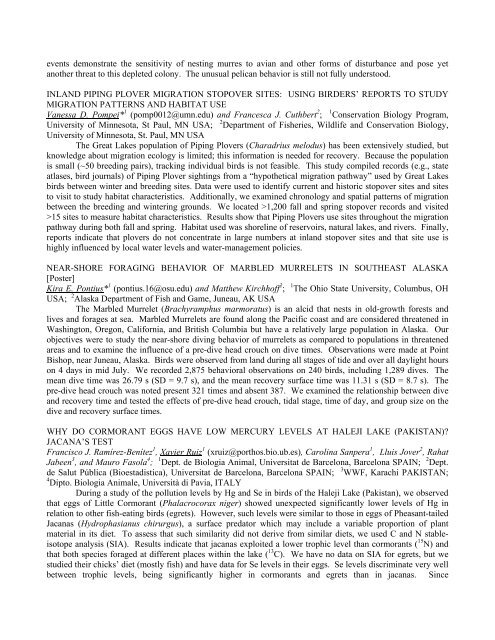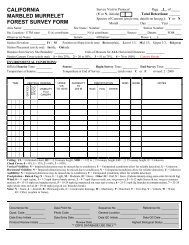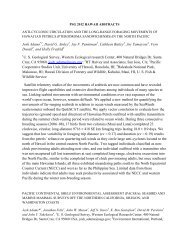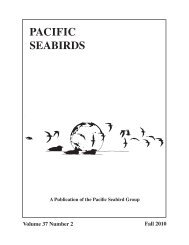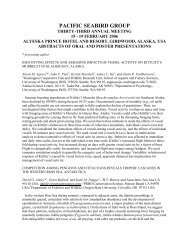abstracts of oral and poster presentations - Pacific Seabird Group
abstracts of oral and poster presentations - Pacific Seabird Group
abstracts of oral and poster presentations - Pacific Seabird Group
Create successful ePaper yourself
Turn your PDF publications into a flip-book with our unique Google optimized e-Paper software.
events demonstrate the sensitivity <strong>of</strong> nesting murres to avian <strong>and</strong> other forms <strong>of</strong> disturbance <strong>and</strong> pose yet<br />
another threat to this depleted colony. The unusual pelican behavior is still not fully understood.<br />
INLAND PIPING PLOVER MIGRATION STOPOVER SITES: USING BIRDERS’ REPORTS TO STUDY<br />
MIGRATION PATTERNS AND HABITAT USE<br />
Vanessa D. Pompei* 1 (pomp0012@umn.edu) <strong>and</strong> Francesca J. Cuthbert 2 ; 1 Conservation Biology Program,<br />
University <strong>of</strong> Minnesota, St Paul, MN USA; 2 Department <strong>of</strong> Fisheries, Wildlife <strong>and</strong> Conservation Biology,<br />
University <strong>of</strong> Minnesota, St. Paul, MN USA<br />
The Great Lakes population <strong>of</strong> Piping Plovers (Charadrius melodus) has been extensively studied, but<br />
knowledge about migration ecology is limited; this information is needed for recovery. Because the population<br />
is small (~50 breeding pairs), tracking individual birds is not feasible. This study compiled records (e.g., state<br />
atlases, bird journals) <strong>of</strong> Piping Plover sightings from a “hypothetical migration pathway” used by Great Lakes<br />
birds between winter <strong>and</strong> breeding sites. Data were used to identify current <strong>and</strong> historic stopover sites <strong>and</strong> sites<br />
to visit to study habitat characteristics. Additionally, we examined chronology <strong>and</strong> spatial patterns <strong>of</strong> migration<br />
between the breeding <strong>and</strong> wintering grounds. We located >1,200 fall <strong>and</strong> spring stopover records <strong>and</strong> visited<br />
>15 sites to measure habitat characteristics. Results show that Piping Plovers use sites throughout the migration<br />
pathway during both fall <strong>and</strong> spring. Habitat used was shoreline <strong>of</strong> reservoirs, natural lakes, <strong>and</strong> rivers. Finally,<br />
reports indicate that plovers do not concentrate in large numbers at inl<strong>and</strong> stopover sites <strong>and</strong> that site use is<br />
highly influenced by local water levels <strong>and</strong> water-management policies.<br />
NEAR-SHORE FORAGING BEHAVIOR OF MARBLED MURRELETS IN SOUTHEAST ALASKA<br />
[Poster]<br />
Kira E. Pontius* 1 (pontius.16@osu.edu) <strong>and</strong> Matthew Kirchh<strong>of</strong>f 2 ; 1 The Ohio State University, Columbus, OH<br />
USA; 2 Alaska Department <strong>of</strong> Fish <strong>and</strong> Game, Juneau, AK USA<br />
The Marbled Murrelet (Brachyramphus marmoratus) is an alcid that nests in old-growth forests <strong>and</strong><br />
lives <strong>and</strong> forages at sea. Marbled Murrelets are found along the <strong>Pacific</strong> coast <strong>and</strong> are considered threatened in<br />
Washington, Oregon, California, <strong>and</strong> British Columbia but have a relatively large population in Alaska. Our<br />
objectives were to study the near-shore diving behavior <strong>of</strong> murrelets as compared to populations in threatened<br />
areas <strong>and</strong> to examine the influence <strong>of</strong> a pre-dive head crouch on dive times. Observations were made at Point<br />
Bishop, near Juneau, Alaska. Birds were observed from l<strong>and</strong> during all stages <strong>of</strong> tide <strong>and</strong> over all daylight hours<br />
on 4 days in mid July. We recorded 2,875 behavi<strong>oral</strong> observations on 240 birds, including 1,289 dives. The<br />
mean dive time was 26.79 s (SD = 9.7 s), <strong>and</strong> the mean recovery surface time was 11.31 s (SD = 8.7 s). The<br />
pre-dive head crouch was noted present 321 times <strong>and</strong> absent 387. We examined the relationship between dive<br />
<strong>and</strong> recovery time <strong>and</strong> tested the effects <strong>of</strong> pre-dive head crouch, tidal stage, time <strong>of</strong> day, <strong>and</strong> group size on the<br />
dive <strong>and</strong> recovery surface times.<br />
WHY DO CORMORANT EGGS HAVE LOW MERCURY LEVELS AT HALEJI LAKE (PAKISTAN)<br />
JACANA’S TEST<br />
Francisco J. Ramírez-Benítez 1 , Xavier Ruiz 1 (xruiz@porthos.bio.ub.es), Carolina Sanpera 1 , Lluis Jover 2 , Rahat<br />
Jabeen 3 , <strong>and</strong> Mauro Fasola 4 ; 1 Dept. de Biologia Animal, Universitat de Barcelona, Barcelona SPAIN; 2 Dept.<br />
de Salut Pública (Bioestadistica), Universitat de Barcelona, Barcelona SPAIN; 3 WWF, Karachi PAKISTAN;<br />
4 Dipto. Biologia Animale, Università di Pavia, ITALY<br />
During a study <strong>of</strong> the pollution levels by Hg <strong>and</strong> Se in birds <strong>of</strong> the Haleji Lake (Pakistan), we observed<br />
that eggs <strong>of</strong> Little Cormorant (Phalacrocorax niger) showed unexpected significantly lower levels <strong>of</strong> Hg in<br />
relation to other fish-eating birds (egrets). However, such levels were similar to those in eggs <strong>of</strong> Pheasant-tailed<br />
Jacanas (Hydrophasianus chirurgus), a surface predator which may include a variable proportion <strong>of</strong> plant<br />
material in its diet. To assess that such similarity did not derive from similar diets, we used C <strong>and</strong> N stableisotope<br />
analysis (SIA). Results indicate that jacanas exploited a lower trophic level than cormorants ( 15 N) <strong>and</strong><br />
that both species foraged at different places within the lake ( 13 C). We have no data on SIA for egrets, but we<br />
studied their chicks’ diet (mostly fish) <strong>and</strong> have data for Se levels in their eggs. Se levels discriminate very well<br />
between trophic levels, being significantly higher in cormorants <strong>and</strong> egrets than in jacanas. Since


